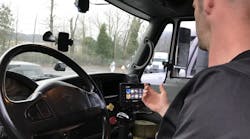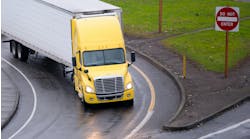Editor's note: This is the third part of a week-long series looking at what fleets need to do ahead of the December deadline to end use of AOBRDs. Read part 1 and part 2.
Whichever option a fleet is leaning toward when changing or upgrading electronic logging devices (ELDs), Adam Bruttell, vice president of sales and marketing at MiX Telematics, said to make sure the solution provides all of the hours-of-service rulesets required. This is particularly important for those operating in heavily regulated industries, such as oil, gas and hazardous materials.
Bruttell also urged fleets to inquire about the requirement that broken devices be fixed within eight days before making a final choice. He considers it a detail that not enough people are talking about, but should have fleet managers asking providers for their plans to ensure they are fixed, regardless of where the truck is located when a problem arises.
Drivers in this situation should make sure they keep eight days of paper logs in the vehicle to limit any problems if there is a roadside inspection during this time.
EROAD pointed out fleets may also need to think about new cables that allow an ELD to extend outside the cab to reach law enforcement. If it turns out an existing device needs to be replaced, EROAD advises fleets to ask about who will cover those costs, how much downtime is involved, and whether historical AOBRD data can be migrated to the new solution.
Even for fleets satisfied with their ELDs, Eric Witty, vice president of product for Trimble’s Transportation Div., believes they should be asking their providers what updates they plan to offer going forward. In Trimble’s case, he said the company is not just looking at compliance but focusing on the “next level” of features and functionality.
For fleets considering an upgrade, they may find costs, installation time, and training commitments have fallen from when they initially invested in ELDs.
Zonar is one provider with a special emphasis on ensuring compliance. Its logs are third-party validated by industry veteran Annette Sandberg, a former FMCSA administrator, and it has successfully completed testing with FMCSA to confirm data transfer to an authorized safety official’s laptop.
Fred Fakkema, vice president of compliance at Zonar, is a former commercial vehicle inspector, providing customers with an inside perspective on how to ease the roadside inspection process. Like many competitors, Zonar plans to provide over-the-air software updates to convert AOBRDs into fully compliant ELDs.
The ability to switch to an ELD, or into ELD mode, without changing components of an existing AOBRD system with zero cost is a key message from a company known as ELD Solutions. It focuses on providing a simple experience through a driver app and customer portal that requires minimal user interaction.
Separate offerings include a dedicated tablet device, a hardwired device option providing a more secure connection, and a “bring your own device” option for those seeking “affordable, flexible” solutions.
A new, low-cost option is the “pay-as-you-drive” ELD from BigRoad. It is for drivers that do not regularly need an ELD, such as those operating on a seasonal basis. There are no contracts, cancellation fees, or upfront hardware costs.
For those opting for more of a complete system, they often offer a growing number of integrations with other apps such as weigh station bypass, navigation and fuel tax reporting.
One recently announced integration came from J.J. Keller and Trucker Tools. Keller’s customers gained the option to share load-specific location data with the Trucker Tools automated shipment tracking software and can get access to information about available loads from the Trucker Tools’ broker community.
Even with all of the various options available, Bruttell said he thought that it is inevitable that a small percentage of truckers will instead wait for having a violation or getting a ticket before they adopt a compliant ELD. Those who choose that path should be prepared to convert before heading back out to deliver another load.
Coming Thursday: What could the sunsetting of existing communication networks mean for older ELDs?



